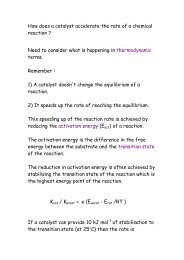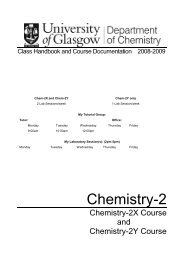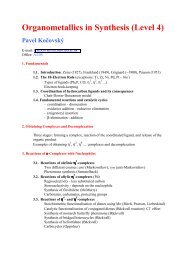Link to PDF - School of Chemistry - University of Glasgow
Link to PDF - School of Chemistry - University of Glasgow
Link to PDF - School of Chemistry - University of Glasgow
You also want an ePaper? Increase the reach of your titles
YUMPU automatically turns print PDFs into web optimized ePapers that Google loves.
Downloaded on 16 January 2012<br />
Published on 23 December 2011 on http://pubs.rsc.org | doi:10.1039/C2DT11919F<br />
Dal<strong>to</strong>n<br />
Transactions<br />
Dynamic Article <strong>Link</strong>s<br />
Cite this: DOI: 10.1039/c2dt11919f<br />
www.rsc.org/dal<strong>to</strong>n PAPER<br />
Exploring the rotational isomerism in non-classical Wells–Dawson anions<br />
{W18X}: a combined theoretical and mass spectrometry study†<br />
Laia Vilà-Nadal, a,b Scott G. Mitchell, a De-Liang Long, a An<strong>to</strong>nio Rodríguez-Fortea, b Xavier López, b<br />
Josep M. Poblet* b and Leroy Cronin* a<br />
Received 12th Oc<strong>to</strong>ber 2011, Accepted 6th December 2011<br />
DOI: 10.1039/c2dt11919f<br />
We present a combined theoretical and mass spectrometry study <strong>of</strong> the rotational isomerism <strong>of</strong> the<br />
non-classical Wells–Dawson anions. The structure is larger than the Keggin anion and six geometric<br />
isomers are predicted (a, b, g, a*, b*, g*) on the basis <strong>of</strong> structural arguments. This work explores the<br />
geometrical differences between the isomers and evaluates the stability <strong>of</strong> these unusual clusters based<br />
upon the inclusion <strong>of</strong> the different heteroa<strong>to</strong>ms. We connect the theoretical results with experimental<br />
studies by exploring the fragmentation <strong>of</strong> the parent clusters by electrospray-ionisation mass<br />
spectrometry (ESI-MS). Both approaches show a general stability trend that can be postulated as<br />
follows: g* > b* > a* > a ≫ b > g where the isomers g*, b*anda are the only anions <strong>of</strong> this type<br />
known <strong>to</strong> have been synthesised.<br />
Introduction<br />
Polyoxometalates (POMs) 1 are an outstanding family <strong>of</strong> compounds,<br />
well known for their huge structural diversity, 2 interesting<br />
catalytic activities 3 and rich electrochemistry. 4 POMs are<br />
comprised <strong>of</strong> metal oxide building blocks with a general formula<br />
{MO x} n,whereM= Mo, W, V, and sometimes Nb and x =<br />
3–7. 5 The embedding <strong>of</strong> tetrahedral ([SO 4] 2- ,[PO 4] 3- ,[SiO 4] 4- ),<br />
octahedral ([IO 6] 5- , [TeO 6] 6- ) or pyramidal ([SO 3] 2- , [BiO 3] 3- )<br />
anions in the POM structure leads <strong>to</strong> the subfamily <strong>of</strong> heteropolyoxometalates<br />
(HPOMs). From a structural point <strong>of</strong> view,<br />
POMs are highly ordered clusters with additional architectures<br />
arising from the existence <strong>of</strong> various isomeric forms, notably<br />
in the common [XM 12O 40] q- Keggin 6 and [X 2M 18O 62] 2q- Wells–<br />
Dawson (WD) 7 structures. Using the Clathrate model the WD<br />
anion can be viewed as two charged [XO 4] q- tetrahedral anions<br />
encapsulated by a neutral [M 18O 54] cage,whereX= P, 7 As, 8 S 9 or<br />
V 10 Conventionally, redox-inactive anions, such as [SO 4] 2- ,[PO 4] 3and<br />
[AsO 4] 3- are <strong>of</strong>ten used as templating anions in the formation<br />
<strong>of</strong> many WD clusters. However a recent strategy designed by<br />
us 11–13 <strong>to</strong> create new functional POMs involves the encapsulation<br />
<strong>of</strong> redox-active templates instead. By utilising [SO 3] 2- ,[SeO 3] 2- ,<br />
[TeO 6] 6- , and [IO 6] 5- anions as templates, several new types <strong>of</strong><br />
a WestCHEM, <strong>School</strong> <strong>of</strong> <strong>Chemistry</strong>, The <strong>University</strong> <strong>of</strong> <strong>Glasgow</strong>, <strong>Glasgow</strong>,<br />
UK, G12 8QQ. E-mail: L.Cronin@chem.gla.ac.uk; Fax: (+44) 141-330-<br />
4888; Tel: (+44) 141-330-6650; Web: http://www.croninlab.com<br />
b Departament de Química Física i Inorgànica, Universitat Rovira i Virgili,<br />
c/Marcel·lí Domingo s/n, 43007, Tarragona, Spain. E-mail: josepmaria.poblet@urv.cat;<br />
Fax: (+34) 977-559-563; Tel: (+34) 977-559-569;<br />
Web: http://www.quimica.urv.es/w3qf/<br />
† Electronic supplementary information (ESI) available: information regarding<br />
CID-MS fragmentation experiments and DFT calculations. See<br />
DOI: 10.1039/c2dt11919f<br />
View Online / Journal Homepage<br />
redox-active non-classical WD HPOMs have been isolated. In<br />
three examples where X = W VI ,Te VI or I VII both anionic templates<br />
are replaced by one central templating octahedral anion, [XO 6] p- <strong>to</strong><br />
give the [W 18O 56(XO 6)] (4+p)- {W 18X} type POM. The first member<br />
<strong>of</strong> this family <strong>to</strong> be discovered was actually an isopolyanion<br />
{W 19} = {W 18W} with a Wells–Dawson-type cage; the nineteenth<br />
tungsten is located at the centre <strong>of</strong> the cluster instead <strong>of</strong> the two<br />
tetrahedral heteroa<strong>to</strong>ms that are usually found inside conventional<br />
Dawson clusters. 11 Structural analysis <strong>of</strong> the cluster shows that the<br />
nineteenth tungsten could be replaced by other elements, such as<br />
Sb V ,Te VI ,orI VII . The anions b*-[H 3W 18O 56(IO 6)] 6- embedded with<br />
high-valent iodine 12 and g*-[H 3W 18O 56(TeO 6)] 7- that captures the<br />
tellurate anion TeO 6 6- were discovered thereafter (Fig. 1). 13<br />
Fig. 1 Structures <strong>of</strong> the non-classical Wells–Dawson {W 18X} type<br />
POM. The {W 18} cages are shown as a wireframe and the central<br />
octahedral {XO 6} group is represented as a space-filling model. Left:<br />
a-[W 18O 56(WO 6)] 10- . Middle: g*-[W 18O 56(XO 6)] 10- X = W VI and Te VI . Right:<br />
b*-[W 18O 56(IO 6)] 9- . Colour code for spheres and wires is the following, W =<br />
grey, O = red, Te = green, I = blue.<br />
Although isomerism in POMs has been studied in isolated<br />
reports with their properties explored both experimentally and<br />
This journal is © The Royal Society <strong>of</strong> <strong>Chemistry</strong> 2012 Dal<strong>to</strong>n Trans.
Downloaded on 16 January 2012<br />
Published on 23 December 2011 on http://pubs.rsc.org | doi:10.1039/C2DT11919F<br />
computationally, some basic points are still unclear. However,<br />
tuning physical properties using the geometrical changes found<br />
for an isomer, such as the different location <strong>of</strong> a given a<strong>to</strong>m<br />
(positional isomerism), or a rotation <strong>of</strong> a fragment <strong>of</strong> the molecule<br />
(rotational isomerism) would be interesting. Six isomers for the<br />
[X 2M 18O 62] 6- anion (X = As V ,P V ;M= Mo VI ,W VI ) were postulated<br />
in 1970 by Baker and Figgis and named a, b, g and a*, b*,<br />
g*. 14 The same notation has been used for the {W 18X} isomers,<br />
depicted in Fig. 2. Since heteroa<strong>to</strong>ms As or P and I or Te are<br />
located either at the centre <strong>of</strong> the cluster (non-classical WDs) or<br />
symmetrically located on C 3 axis (classical WDs) their existence<br />
does not affect the symmetries <strong>of</strong> the clusters, therefore both the<br />
classic [X 2M 18O 62] 2q- and non-classic [W 18O 56(XO 6)] (4+p)- WDs can<br />
share the same symmetrical system notations.<br />
Fig. 2 The six rotational isomers <strong>of</strong> the non-classical Wells–Dawson<br />
{W 18X} structure. Top: a, b, g. Bot<strong>to</strong>m: a*, b*, g*.<br />
As depicted in Fig. 2 and 3, all the a, b, g isomers have a<br />
D 3h symmetric trigonal prism [XO 6] p- moiety inside the clusters,<br />
while all the a*, b*, g* isomers have a D 3d symmetric trigonal<br />
antiprism [XO 6] p- moiety. The a-[W 18O 56(XO 6)] (4+p)- (X = W VI ,Te VI<br />
and I VII ) isomer has a D 3h symmetric {W 18O 54} cage shell and<br />
the whole cluster belongs <strong>to</strong> D 3h point group 15 in which all the<br />
oxo ligands <strong>of</strong> the [XO 6] p- moiety bridge pair <strong>of</strong> W a<strong>to</strong>ms within<br />
square windows <strong>of</strong> the {W 9O 34} half. The b anion, see Fig. 3 for<br />
more details, is derived from the a isomer by a formal rotation<br />
by p/3 <strong>of</strong> a polar (cap) W 3O 13 group: the cluster symmetry is<br />
lowered <strong>to</strong> C 3v. A formal rotation by p/3 <strong>of</strong> the second polar<br />
M 3O 13 group res<strong>to</strong>res the symmetry plane and the point group D 3h<br />
for the g isomer. If the two belt {a-W 9O 34} subunits are related<br />
through an inversion centre, as postulated by Wells 16 in 1945 for<br />
[P 2W 18O 62] 6- , the resulting anion named a* hasaD 3d symmetric<br />
{W 18O 54} cage shell and its cluster symmetry belongs <strong>to</strong> the D 3d<br />
point group. Rotation <strong>of</strong> one or both polar (cap) M 3O 13 groups<br />
<strong>of</strong> this a* anion would generate the two remaining isomers, b*<br />
(C 3v)andg*(D 3d) respectively. 17 As depicted in Table 1, five <strong>of</strong> the<br />
six isomers have been detected and solved by single crystal X-ray<br />
diffraction and only the a* isomer remains synthetically elusive.<br />
It is also worthy <strong>of</strong> note that there are two tetrahedral “voids” in<br />
the non-classical WDs at the positions that are typically occupied<br />
by the heteroa<strong>to</strong>ms in conventional WD cluster anions, see Fig. 1.<br />
These positions are pro<strong>to</strong>nated and form H-bonds, similar <strong>to</strong> what<br />
Table 1 Observed isomers for the classic {W 18X 2} and non-classical<br />
{W 18X} Wells–Dawson structures when M = WorMo a<br />
Isomers<br />
Metal a b g a* b* g*<br />
View Online<br />
Classic WD {(XO 4) 2M 18O 54}<br />
M = W PO 4 3-b PO 4 3-c PO 4 3-d PO 4 3-e<br />
AsO 4 3-f AsO 4 3-e AsO 4 3-e SO 4 2-g<br />
SO 4 2-h<br />
M = Mo PO 4 3-i<br />
AsO 4 3-j<br />
SO 4 2-¢k<br />
Non-classical WD {(XO 3) 2M 18O 54}<br />
M = W SO 3 2-h<br />
BiO 3 3-l<br />
AsO 3 3-m<br />
M = Mo SO 3 2-n<br />
P 2O 7 4-o<br />
Non-classical WD {(XO 6)M 18O 56} p<br />
M = W WO 6 6-q IO 6 5-r WO6 6-q<br />
TeO 6 6-s<br />
a Blank spaces correspond <strong>to</strong> non observed isomers. b Ref. 7 c Ref. 23. d Ref.<br />
24. e Ref.8c f Ref.8a g Ref. 25. h Ref. 9. i Ref. 26. j Ref.8b k Ref. 27. l Ref. 28.<br />
m Ref. 29. n Ref. 30. o Ref. 31. p Anions with formula {(XO6)M 18O 56}have<br />
not been observed for M = Mo. q Ref. 11. r Ref. 12. s Ref. 13.<br />
Fig. 3 Top: rationalisation <strong>of</strong> the 18 metal-centred a, b and a* Wells—<br />
Dawson non-classical structures. Bot<strong>to</strong>m: vision along the C 3 axis. In the<br />
a isomer both CAP (red and blue) triads appear eclipsed along the C 3.On<br />
the contrary, the CAP triads appear staggered in the b and a* isomers.<br />
This is due <strong>to</strong> a p/3 rotation <strong>of</strong> the blue CAP in the a isomer that leads <strong>to</strong><br />
the b anion. Another rotation <strong>of</strong> the red CAP in the b isomer will derive<br />
the g isomer, not depicted here. The short-long alternation in the distances<br />
between the oxygen a<strong>to</strong>ms that interconnect both BELT units, depicted in<br />
turquoise, is maintained in the a, b and g isomers. If both CAP–BELT,<br />
{a-W 9O 34} subunits are related through an inversion centre “i”, depicted<br />
in the figure, we obtain the a* isomer with a D 3d symmetry. In this case the<br />
distance alternation between central oxygens (turquoise) disappears. The<br />
same happens with b* andg*, since the oxygens are related through the<br />
improper axis S 6. Like b and g isomers, a p/3 rotation <strong>of</strong> the blue CAP<br />
in the a* isomer will lead <strong>to</strong> the b* and the rotation <strong>of</strong> both CAP (blue<br />
and red) <strong>to</strong> g*. Note from the bot<strong>to</strong>m figures, vision along the C 3 axis,<br />
that [XO 6] p- yellow octahedral appear eclipsed in a, b, consequently in g<br />
isomers, whereas are staggered in a* and subsequently in b*, g*.<br />
isobservedintheKeggincluster[H 2W 12O 40] 6- and the semi-vacant<br />
Dawson polyoxo-tungstate [Ce{P(H 4)W 17O 61} 2] 19- . 11<br />
A. F. Wells stated, in the early sixties, that “there is still<br />
much <strong>to</strong> be learnt about the structures <strong>of</strong> these salts” referring<br />
Dal<strong>to</strong>n Trans. This journal is © The Royal Society <strong>of</strong> <strong>Chemistry</strong> 2012
Downloaded on 16 January 2012<br />
Published on 23 December 2011 on http://pubs.rsc.org | doi:10.1039/C2DT11919F<br />
Table 2 Relative energies (E rel) with respect <strong>to</strong> the most stable isomer, HOMO–LUMO gaps and the X–O inner distance for the six isomers <strong>of</strong><br />
[W 18O 56(XO 6)] (4+p)- where X = W, Te and I, compared <strong>to</strong> the [W 18O 56] 4- cage<br />
[W 18O 56] 4-a [W 18O 56(WO 6)] 10-b [W 18O 56(TeO 6)] 10-b [W 18O 56(IO 6)] 9-b<br />
c c Isomer Symmetry DErel DErel H–L gapd e c dX–Oinner DErel H–L gapd e c dX–Oinner DErel H–L gapd e dX–Oinner a D 3h 0.0 9.1 1.3 2.00 13.3 0.8 2.14 19.7 0.2 2.14<br />
b C 3v 1.9 13.0 1.2 2.01–1.99 18.0 0.8 2.14–2.13 24.7 0.1 2.12–2.13<br />
g D 3h 0.0 16.1 1.2 2.00 21.3 0.8 2.14 26.2 f 0.1 2.19<br />
a* D 3d 1.9 7.0 1.7 1.99 4.6 1.7 2.10 5.0 1.1 2.08<br />
b* C 3v 0.0 0.0 1.9 1.85–2.17 1.5 1.7 2.09–2.11 1.5 1.0 2.08–2.07<br />
g* D 3d 1.8 0.1 1.6 1.99 0.0 1.6 2.10 0.0 1.0 2.08<br />
a Geometry optimized BP86, gas phase. b Geometry optimized BP86/SES. c kcal mol -1 . d eV. e A˚ . f triplet.<br />
<strong>to</strong> the iso- and heteropolyacid salts <strong>of</strong> polyoxometalates known<br />
at the time. 18 Since Dawson solved the crystal structure <strong>of</strong> a-<br />
K 6[P 2W 18O 62]·14H 2O 7a there has been renewed and considerable<br />
effort during the last decades (see Table 1) <strong>to</strong> understand and<br />
control isomerism in POMs. At first glance, the a isomer in<br />
Table 1 appears as the most common structure, regardless <strong>of</strong><br />
the heteroa<strong>to</strong>m. Therefore the a configuration <strong>of</strong> the W 18 ‘box’<br />
is the most flexible among all isomers, being able <strong>to</strong> stabilise the<br />
classic [XO 4] q- and non-classic [XO 3] q- ,[XO 6] p- heteroanions. By<br />
observing the amount <strong>of</strong> blank spaces left in Table 1 and the fact<br />
that b* isomer is only obtained when the heteroanion is [IO 6] 5- ,<br />
one can easily attempt <strong>to</strong> predict a stability order for the isomers<br />
(a > g* > gªb> b* > a*), where a and g* are most stable,<br />
and thus the most observed isomers. Significant contributions <strong>to</strong><br />
this field have been made by Contant and Thouvenot, who have<br />
already discussed geometrical differences between isomers and the<br />
stability <strong>of</strong> g*, stating that it is the most stable among the staggered<br />
structures. 8c In a previous DFT study, Poblet and co-workers<br />
analysed the relative stability <strong>of</strong> the a and b isomers <strong>of</strong> the Wells–<br />
Dawson (WD) heteropolyanions. 19a In a more recent DFT study<br />
by Su and co-workers the following stability trend has been found<br />
for isomers <strong>of</strong> [P 2W 18O 62] 6- (a > b > g > g*> a*> b*). 20 Our aim<br />
here is <strong>to</strong> study, by means <strong>of</strong> DFT, the non-classical WD {W 18X}<br />
and understand their preferences for certain conformations. We<br />
have complemented the theoretical study using electrosprayionisation<br />
mass spectrometry (ESI-MS) experiments. Cronin and<br />
co-workers have recently demonstrated that a combination <strong>of</strong><br />
cation-exchange and electrospray-ionisation mass spectrometry<br />
(ESI-MS) can be used as a versatile <strong>to</strong>ol <strong>to</strong> elucidate the complete<br />
cluster composition, including the degree <strong>of</strong> pro<strong>to</strong>nation, as well<br />
as determining the relative proportions <strong>of</strong> the cluster species<br />
present in solution. 21 POM clusters represent ideal candidates for<br />
examination using high-resolution mass spectrometry since they<br />
are intrinsically charged and have characteristic iso<strong>to</strong>pic envelopes,<br />
which can be precisely fitted <strong>to</strong> determine the exact formula. 22 In<br />
the present paper we will discuss the isomerism <strong>of</strong> the non-classical<br />
WD structure from a theoretical point <strong>of</strong> view.<br />
Results and discussion<br />
Isomerism for non-classical Dawson anions {M 18X} a, b, c, a*, b*,<br />
c* whenM= W<br />
As a preliminary study we have analysed the relative stability <strong>of</strong><br />
the six isomers <strong>of</strong> the classic Wells–Dawson (WD) [X 2M 18O 62] 2q-<br />
View Online<br />
heteropolyanions when X = P, As or S. Geometry optimisations<br />
with symmetry constraints performed on the six isomers <strong>of</strong> WD<br />
anion, when X = P, As and S, led <strong>to</strong> structures listed in Table S1 and<br />
Fig. S1.† For instance, the a isomer <strong>of</strong> As 2W 18 was computed under<br />
the constraints <strong>of</strong> D 3h symmetry, whereas for the corresponding b<br />
isomer we have assumed the symmetry <strong>of</strong> the molecule is C 3v, etc.<br />
For the six isomers <strong>of</strong> [P 2W 18O 62] 6- ,[As 2W 18O 62] 6- and [S 2W 18O 62] 4we<br />
have obtained the same stability trend as Su and co-workers. 20<br />
Here, we have extended that previous work <strong>to</strong>wards the nonclassical<br />
WD {W 18X} anions <strong>to</strong> explore the effect <strong>of</strong> including<br />
the single central heteroanion.<br />
Due <strong>to</strong> the presence <strong>of</strong> pro<strong>to</strong>ns in {W 18X} species, the full<br />
analysis <strong>of</strong> the isomerism in non-classical WD anions is more<br />
complex compared <strong>to</strong> their {W 18X 2} analogues. At this initial<br />
stage, and for reasons <strong>of</strong> simplicity, we have not included pro<strong>to</strong>ns<br />
in the {W 18} cage, and consequently the charge <strong>of</strong> the anion has<br />
increased, i.e. instead <strong>of</strong> [H 3W 18O 56(IO 6)] 6- we have studied the<br />
[W 18O 56(IO 6)] 9- species. Table 2 shows the relative energies with<br />
respect <strong>to</strong> the most stable isomer for the [W 18O 56(XO 6)] (4+p)- WD<br />
type isomer. We have first evaluated the relative stability <strong>of</strong> the six<br />
isomers considering only the [W 18O 56] 4- cage without the internal<br />
anions [XO 6] p- , observing the same trend as the [W 18O 54] cage<strong>of</strong><br />
classic WD isomers (see Table S1†). The six isomers for both cases,<br />
i.e. [W 18O 56] 4- and [W 18O 54], are quasi degenerate structures. So, the<br />
stability <strong>of</strong> one isomer is not determined by the stability <strong>of</strong> the cage,<br />
it strongly depends on the interactions <strong>of</strong> the encapsulated anion<br />
embedded within it.<br />
From the results for [W 18O 56(XO 6)] (4+p)- when X = W, Te and<br />
I, it is interesting <strong>to</strong> point out that the a*, b* andg* group <strong>of</strong><br />
isomers is by far the more stable (more than 10 kcal mol -1 )than<br />
the group formed by the a, b and g isomers. See in Table S1†<br />
that, for the classic WD structures, the most stable isomers are the<br />
a, b, g and g*. The main geometrical differences between the six<br />
non-classical isomers have been shown in Fig. 2. Here we would<br />
like <strong>to</strong> highlight that the internal oxygens for [W 18O 56(XO 6)] (4+p)are<br />
eclipsed in isomers a, b, g and staggered in a*, b*, g* (see<br />
Fig. 4 bot<strong>to</strong>m). This geometrical difference determines the relative<br />
stability <strong>of</strong> these isomers, the latter being, in general, more than<br />
10 kcal mol -1 lower in energy than the former. In a previous<br />
paper, we analysed the stability trend <strong>of</strong> {W 19} isomers from a<br />
theoretical point <strong>of</strong> view. 11 In contrast <strong>to</strong> these previous results<br />
we found that the D 3h-symmetric a isomer is more stable than<br />
the D 3d-symmetric g* isomer. Despite the use <strong>of</strong> different codes<br />
in the analyses (Turbomole and ADF) the levels <strong>of</strong> theory used<br />
in both cases are comparable. However the omission <strong>of</strong> solvent<br />
This journal is © The Royal Society <strong>of</strong> <strong>Chemistry</strong> 2012 Dal<strong>to</strong>n Trans.
Downloaded on 16 January 2012<br />
Published on 23 December 2011 on http://pubs.rsc.org | doi:10.1039/C2DT11919F<br />
Fig. 4 Above: graphical representation <strong>of</strong> the HOMO–LUMO gap, in<br />
eV, for a (D 3h)anda*(D 3d) isomers <strong>of</strong> [W 18O 56(IO 6)] 9- . 3D representations<br />
for the HOMO (orbital delocalized over the inner oxygen a<strong>to</strong>ms) and the<br />
LUMO (orbital delocalised over the I a<strong>to</strong>m and the inner oxygen a<strong>to</strong>ms).<br />
Below: Wells–Dawson-like structures {W 18X} POM type, the {W 18} cages<br />
are shown as sticks and the central {XO 6} group is represented as space<br />
filling model, X: blue sphere; O: red sphere. Left: for the a isomer the inner<br />
oxygen a<strong>to</strong>ms appear eclipsed; the same happens for the b and g isomers.<br />
Right: for the a* isomer the inner oxygen a<strong>to</strong>ms appear staggered as they<br />
are for b*andg* isomers.<br />
in previous calculations appears <strong>to</strong> be a key fac<strong>to</strong>r in establishing<br />
the correct relative stabilities <strong>of</strong> the POMs, and this is a plausible<br />
explanation for the differences encountered when comparing both<br />
stability trends.<br />
The higher stability <strong>of</strong> isomers a*, b* andg* in the nonclassical<br />
structures can be easily rationalised from the analysis<br />
<strong>of</strong> the frontier orbitals. On one hand, the HOMO–LUMO (H–L)<br />
gaps are considerably larger for these isomers compared <strong>to</strong> a, b<br />
and g isomers: ~0.9 eV in the case <strong>of</strong> X = Te, I and slightly smaller<br />
(~0.6 eV) in the case <strong>of</strong> X = W. On the other hand, we have also<br />
found geometrical differences in the X–O inner distances: they are<br />
larger (~0.05 A˚ ,X= I) in the a, b, g isomers than in a*, b*, g*.<br />
Fig. 4 aims <strong>to</strong> summarise these observations for isomers a and a*<br />
in the case <strong>of</strong> [W 18O 56(IO 6)] 9- .<br />
AsshowninTable2,thea isomer <strong>of</strong> the [W 18O 56(IO 6)] 9- anion<br />
is about 21 kcal mol -1 higher in energy than the a* isomer. This<br />
high energy arises from the eclipsed conformation <strong>of</strong> the internal<br />
oxygen a<strong>to</strong>ms. In fact, the HOMO lies quite high in energy and<br />
the H–L gap is rather small. Both fac<strong>to</strong>rs are a sign <strong>of</strong> instability.<br />
View Online<br />
As for a* isomer the 60 ◦ degrees rotation <strong>of</strong> one O 3 unit in the<br />
heterogroup {IO 6} leads <strong>to</strong> a relaxation <strong>of</strong> the system and is<br />
associated with a stabilisation <strong>of</strong> the HOMO and a destabilisation<br />
<strong>of</strong> the LUMO, thus an increase <strong>of</strong> the H–L gap. This is due <strong>to</strong> the<br />
eclipsed disposition <strong>of</strong> inner O a<strong>to</strong>ms in the a isomer.<br />
The antibonding interactions among oxygen a<strong>to</strong>ms in the<br />
HOMO <strong>of</strong> the a isomer are more important than in the HOMO<br />
<strong>of</strong> a*, where these interactions are minimised thanks <strong>to</strong> the<br />
staggered disposition <strong>of</strong> inner O a<strong>to</strong>ms. The key parameter in<br />
the destabilisation for a* LUMO orbital is the distance between<br />
central a<strong>to</strong>m and inner oxygen a<strong>to</strong>ms. As we have said previously<br />
this distance is slightly smaller for a* isomer. Therefore, the<br />
antibonding X–O interactions in the LUMO are much more<br />
effective than those in the LUMO <strong>of</strong> the a isomers, thus becoming<br />
more destabilised than the a LUMO.<br />
An average difference in stability around 7 kcal mol -1 was<br />
computed for several classical WD isomers that have been<br />
experimentally characterised in close agreement with recent results<br />
<strong>of</strong> Su and co-workers. 20 The values in Table 2 show that the a<br />
isomer <strong>of</strong> [W 18O 56(WO 6)] 10- is 9 kcal mol -1 less stable than g*.<br />
Both isomers have been observed experimentally, and building on<br />
our previous results for the classic WD system, we decided <strong>to</strong><br />
explore role <strong>of</strong> pro<strong>to</strong>ns in the relative stability <strong>of</strong> these molecules.<br />
We therefore modelled the pro<strong>to</strong>nation <strong>of</strong> the two m 3-O a<strong>to</strong>ms,<br />
which are the most basic, as observed in the electrostatic potential<br />
distribution map in Fig. 5.<br />
Fig. 5 Left: highlighted in bright red the two pro<strong>to</strong>nated m 3-O. Right:<br />
image <strong>of</strong> the electrostatic potential for [W 18O 56(WO 6)] 10- highlighting the<br />
m 3-O electronegative sites. Coloured regions correspond <strong>to</strong> the following<br />
scale being (most negative) red < yellow < green < light blue < dark blue<br />
(most positive).<br />
Pro<strong>to</strong>nation <strong>of</strong> the two internal m 3-O a<strong>to</strong>ms in [W 18O 56(WO 6)] 10has<br />
two noticeable consequences: a) it reduces the energy difference<br />
among all six isomers, five <strong>of</strong> them being in energy range lower<br />
than 5 kcal mol -1 and b) the computed geometries are closer <strong>to</strong> the<br />
experimental ones. We have also compared the distances between<br />
the two m 3-O a<strong>to</strong>ms from the X-ray structure and the computed<br />
pro<strong>to</strong>nated and non-pro<strong>to</strong>nated species, the results are shown in<br />
Table 3. For the non-pro<strong>to</strong>nated systems the distance between<br />
the two apical oxygen a<strong>to</strong>ms was computed <strong>to</strong> be 7.9 A˚ . Upon<br />
dipro<strong>to</strong>nation this distance is reduced by ca. 0.4 A˚ .<br />
Stability insights arising from CID-MS fragmentation experiments<br />
One <strong>of</strong> the great tasks for the synthetic chemist is the complete<br />
characterisation <strong>of</strong> new materials. The accurate determination<br />
Dal<strong>to</strong>n Trans. This journal is © The Royal Society <strong>of</strong> <strong>Chemistry</strong> 2012
Downloaded on 16 January 2012<br />
Published on 23 December 2011 on http://pubs.rsc.org | doi:10.1039/C2DT11919F<br />
Table 3 Relative energies (E rel) and distances between apical oxygen a<strong>to</strong>ms for the dipro<strong>to</strong>nated species <strong>of</strong> [W 18O 56(XO 6)] q- where X = W, Te and I<br />
[H 2W 18O 56(WO 6)] 8- [H 2W 18O 56(TeO 6)] 8- [H 2W 18O 56(IO 6)] 7-<br />
d O ◊◊◊O b d O ◊◊◊O b d O ◊◊◊O b<br />
Isomer E rel a X-ray DFT E rel a X-ray DFT E rel a X-ray DFT<br />
a 3.9 7.39 7.57<br />
(7.92)<br />
9.4 14.3<br />
b 4.8 14.5 18.6<br />
g 12.4 16.6 c<br />
a* 4.0 7.1 7.0<br />
b* 0.0 3.7 3.1 7.47 7.53<br />
(7.85)<br />
g* 1.1 7.35 7.57<br />
0.0 7.39 7.64<br />
0.0<br />
(7.96)<br />
(7.94)<br />
a Relative energies with respect <strong>to</strong> the most stable isomer in kcal mol -1 . b Distance between the two apical oxygen a<strong>to</strong>ms in A˚ . In parenthesis the computed<br />
distances for the non pro<strong>to</strong>nated species. c We have not optimised the pro<strong>to</strong>nated geometry.<br />
<strong>of</strong> formula and structure <strong>of</strong> most polyoxometalates can now be<br />
attained with relative ease. However, understanding the assembly<br />
process still represents a significant challenge: one that is crucial<br />
for further synthetic development and exploitation. The use <strong>of</strong><br />
electrospray mass spectrometry (ESI-MS) <strong>to</strong> investigate POM<br />
systems, as a complementary technique <strong>to</strong> X-ray crystallography<br />
and NMR studies, has increased steadily over the last decade. 32–33<br />
In this respect we recently have gone <strong>to</strong> great effort <strong>to</strong> demonstrate<br />
that electrospray (ESI-) and cryospray mass spectrometry (CSI-<br />
MS) are powerful analytical <strong>to</strong>ols for studying complex metal<br />
oxides in the gas phase. 34 Very <strong>of</strong>ten, comprehensive studies not<br />
only allow the elucidation <strong>of</strong> chemical formula but also provide<br />
important insight in<strong>to</strong> the key structural building blocks present in<br />
solution. 35 In this instance the observed data from fragmentation<br />
studies can be correlated <strong>to</strong> possible mechanisms <strong>of</strong> assembly<br />
<strong>of</strong> the clusters. 36 Although it may be said that fragmentation<br />
studies are generally limited with regards <strong>to</strong> the useful mechanistic<br />
information they provide on self-assembly, any such data that can<br />
be obtained may be used in postulating possible self-assembly<br />
mechanisms. In our previous work, ESI- and CSI-MS studies<br />
showed that many POM clusters retain their structural integrity<br />
in solution and, importantly, have helped us <strong>to</strong> unambiguously<br />
determine the extent <strong>of</strong> pro<strong>to</strong>nation <strong>of</strong> many discrete cluster types.<br />
Here we show how Collision-Induced Dissociation (CID) studies<br />
can be used <strong>to</strong> provide qualitative determination <strong>of</strong> cluster stability<br />
in combination with DFT studies and also provide possible<br />
assembly mechanisms.<br />
As mentioned above, in the non-classical {W 18X} clusters, the<br />
two tetrahedral cavities that are usually occupied by heteroa<strong>to</strong>ms<br />
in conventional Wells–Dawson clusters are vacant, and the<br />
apical interior m 3-O positions are pro<strong>to</strong>nated. Consequently,<br />
the structures for all four <strong>of</strong> the clusters are very similar, but<br />
only ((n-C 3H 7) 4N) 6[g*-H 4W 18O 56(W VI O 6)] and ((n-C 3H 7) 4N) 7[g*-<br />
H 3W 18O 56(Te VI O 6)]·4CH 3CN have identical cluster symmetry and<br />
differ only in the identity <strong>of</strong> the central a<strong>to</strong>ms and pro<strong>to</strong>nation<br />
state. In order <strong>to</strong> evaluate the composition <strong>of</strong> the clusters in the<br />
gas phase and <strong>to</strong> simplify the MS experiments, all four clusters<br />
were prepared as tetra-propylamine salts (((n-C 3H 7) 4N) + =<br />
TPA + ). The principle peaks observed during the course <strong>of</strong><br />
the CID experiments for all compounds were the plenary<br />
polyanions: namely for both ((n-C 3H 7) 4N) 6[a-H 4W 18O 56(W VI O 6)]<br />
and ((n-C 3H 7) 4N) 6[g*-H 4W 18O 56(W VI O 6)]·3CH 3CN these were ((n-<br />
View Online<br />
C 3H 7) 4N) 4[H 4W 19O 62] 2- (m/z 2617.3), ((n-C 3H 7) 4N) 3[H 4W 19O 62] 3-<br />
(m/z 1682.5) and ((n-C 3H 7) 4N) 2[H 4W 19O 62] 4- (m/z 1215.6)<br />
and ((n-C 3H 7) 4N)[H 4W 19O 62] 5- (m/z 935.2) (see Table S6†<br />
and Fig. 6). The associated plenary clusters for compounds<br />
((n-C 3H 7) 4N) 6[b*-H 3W 18O 56(I VII O 6)] and ((n-C 3H 7) 4N) 7[g*-<br />
H 3W 18O 56(Te VI O 6)]·4CH 3CN can also be identified (see<br />
Table S7 and Fig. S3†). The synthesis <strong>of</strong> ((n-C 3H 7) 4N) 6[b*-<br />
H 3W 18O 56(I VII O 6)] represented the first time that the [I VII O 6] 5- ion<br />
had been captured within a polyoxometalate and the first time that<br />
iodine, in its highest valence +7, had been included in a tungsten<br />
oxide cluster and fully characterised crystallographically. ESI-MS<br />
experiments in the original publication and references contained<br />
therein demonstrate that [b*-H 3W 18O 56(I VII O 6)] 6- can be isolated<br />
as a pure polyoxometalate, with no co-crystallised {W 19} species<br />
and can contain several pro<strong>to</strong>nation states (see Fig. S4 and Table<br />
S5†). In order <strong>to</strong> provide qualitative information on the stability<br />
<strong>of</strong> the {W 18X} family, a series <strong>of</strong> CID ESI-MS experiments were<br />
investigated. The triple negatively-charged plenary cluster species<br />
in the mass spectra <strong>of</strong> all four compounds were targeted and<br />
fragmented successively by increasing the collision energy <strong>of</strong> the<br />
MS collision cell. Consequently, it was possible <strong>to</strong> moni<strong>to</strong>r the<br />
exact collision energy required <strong>to</strong> completely fragment the triply<br />
Fig. 6 ESI-MS data <strong>of</strong> ((n-C 3H 7) 4N) 6[a-H 4W 18O 56(W VI O 6)]·6CH 3CN<br />
in ace<strong>to</strong>nitrile showing the plenary cluster fragments observed, from<br />
doubly-charged peak ((n-C 3H 7) 4N) 4[a-H 4W 19O 62] 2- (m/z 2617.3) <strong>to</strong><br />
((n-C 3H 7) 4N)[H 4W 19O 62] 5- (m/z 935.2).<br />
This journal is © The Royal Society <strong>of</strong> <strong>Chemistry</strong> 2012 Dal<strong>to</strong>n Trans.
Downloaded on 16 January 2012<br />
Published on 23 December 2011 on http://pubs.rsc.org | doi:10.1039/C2DT11919F<br />
negatively charged parent plenary polyanion and compare and<br />
contrast these values <strong>to</strong> see if a general trend can be postulated.<br />
The first important observation is that the {g*-W 18Te} telluritebased<br />
Wells–Dawson proved <strong>to</strong> be the least stable under the<br />
experimental conditions (see Table S7†) and fragmented at with<br />
a collision energy <strong>of</strong> 15 eV; whereas the corresponding {g*-W 19}<br />
isomer appeared <strong>to</strong> be the most stable, fragmenting completely at<br />
75 eV. The CID fragmentation experiments, based on the collision<br />
energies required <strong>to</strong> fully fragment the triply charged parent<br />
polyanions, showed the following trend in order <strong>of</strong> decreasing<br />
stability: {g*-W 19} > {a-W 19} > {b*-W 18I} > {g*-W 18Te} (75<br />
eV > 60 eV > 17 eV > 15 eV respectively). It is interesting <strong>to</strong><br />
note that, unconventionally, the b* isomer <strong>of</strong> the {W 18} cage is<br />
stabilised by the presence <strong>of</strong> the [IO 6] 5- contained within and<br />
following several years <strong>of</strong> research in<strong>to</strong> the WD anions, we have<br />
been unable <strong>to</strong> isolate any other b* isomers <strong>of</strong> this cage.<br />
It is important <strong>to</strong> add that CID studies cannot be used as the sole<br />
means <strong>to</strong> elucidate mechanistic pathways directly, since the process<br />
involves the decomposition <strong>of</strong> the cluster, but key information can<br />
be gathered which will <strong>of</strong> course be useful <strong>to</strong> postulate some ideas<br />
that can be used <strong>to</strong> form testable self-assembly hypotheses. It must<br />
therefore be noted that, in addition <strong>to</strong> the parent polyanions, only<br />
isopoly fragments were found in the CID mass spectral data, for<br />
example commonly [W 4O 13] 2- up <strong>to</strong> [W 13O 40] 2- andinthecase<br />
<strong>of</strong> {W 19} up <strong>to</strong> [W 19O 58] 2- . These observations give us valuable<br />
information regarding the potential mechanism <strong>of</strong> formation <strong>of</strong><br />
the {W 18X} systems as well as the stability <strong>of</strong> the synthons that<br />
exist in solution. It would appear that several isopolyanionic<br />
fragments form initially followed by the incorporation <strong>of</strong> the<br />
central {XO 6} template(whereX= W, I, Te) which then undergo<br />
further aggregation <strong>to</strong> form the final product through a simple<br />
condensation process. This trend is in keeping with the idea that<br />
small isonuclear fragments are much more stable, or less labile,<br />
in tungsten-based systems, meaning that template anions may be<br />
incorporated at a later stage in the aggregation process. 34 A recent<br />
publication by us which has analysed the aggregation processes<br />
leading <strong>to</strong>wards the assembly <strong>of</strong> the Keggin anion [XM 12O 40] q- also<br />
concludes that the heteroanion, [XO 2(OH) 2] - , is not incorporated<br />
in<strong>to</strong> the polyanion initially. 36a)<br />
Table 4 compares the Fragmentation Energies (FEs) for g*-<br />
{TeW 18}, b*-{IW 18}, a- andg*-{W 19} clusters obtained in ESI-<br />
MS experiments with Binding Energies (BEs) or a<strong>to</strong>mization<br />
energies computed for the non-pro<strong>to</strong>nated species. Bridgeman and<br />
Cavigliasso have shown that insight in<strong>to</strong> the bonding in POMs can<br />
be afforded using a<strong>to</strong>mization energies. 37 Weareaware<strong>of</strong>thefact<br />
Table 4 Theoretical DFT Binding Energy (BE) in eV for the observed<br />
isomers and a summary the energy required for the <strong>to</strong>tal fragmentation <strong>of</strong><br />
the cluster in the ESI-MS experiments, Fragmentation Energy (FE)<br />
DFT (eV) Experimental (eV)<br />
Isomers BE a DE BE FE b DE FE<br />
g*-[W 18O 56(TeO 6)] 10- -458.9 12 15 60<br />
b*-[W 18O 56(IO 6)] 9- -468.6 3 17 58<br />
a-[W 18O 56(WO 6)] 10- -470.5 1 60 5<br />
g*-[W 18O 56(WO 6)] 10- -471.2 0 75 0<br />
a B.E. (Binding Energy) in gas phase. b F.E. (Fragmentation Energy) in gas<br />
phase<br />
that <strong>to</strong> compare FEs and BEs is not straightforward, since the<br />
former measures the fragmentation energy <strong>to</strong> give some specific<br />
fragments whereas the latter measures the <strong>to</strong>tal decomposition<br />
<strong>of</strong> the anion in a<strong>to</strong>ms. We think, however, that the absolute<br />
magnitudes may yield some qualitative information regarding the<br />
tendency <strong>of</strong> the clusters <strong>to</strong> decompose. For instance both DFT<br />
and experimental data show that {W 19} clusters are more stable<br />
than {TeW 18}, which decomposes at a much lower energy. Further<br />
analysis must be performed <strong>to</strong> both explore and validate this<br />
postulate so <strong>to</strong> carefully compare and extract information from<br />
both experimental ESI-MS and DFT bonding energy analysis.<br />
Conclusions<br />
The classical Wells–Dawson anions can be synthesised as different<br />
isomers a, b, g, a*, b*andg* according <strong>to</strong> the relative disposition<br />
<strong>of</strong> a<strong>to</strong>ms. DFT confirmed that in classical WD anions the stability<br />
order is a > b > g > g*≫ a*> b*. The largest instability <strong>of</strong> a*and<br />
b* explains why these two isomers have yet <strong>to</strong> be observed. ESI-<br />
MS and DFT studies have been carried out <strong>to</strong> analyse the relative<br />
stability for a series <strong>of</strong> non-classical WD anions. In contrast, for<br />
the non-classical WD anions the obtained DFT stability order is<br />
g* > b* > a* > a ≫ b > g where the isomers g*, b*anda are the<br />
only anions <strong>of</strong> this type known <strong>to</strong> have been synthesised so far.<br />
The collision energy necessary <strong>to</strong> induce the <strong>to</strong>tal fragmentation<br />
<strong>of</strong> the {XW 18} parent polyanion by ESI-MS was always found<br />
<strong>to</strong> be lower than the homologous {W 19} species; binding energies<br />
predicted by DFT are in agreement with this general trend. We<br />
have been able <strong>to</strong> rationalise the isomerism in this new class <strong>of</strong><br />
WD anions and explain their preference <strong>to</strong> adopt certain isomerstructures.<br />
In future, we aim <strong>to</strong> perform detailed analyses on the<br />
influence <strong>of</strong> the redox properties on isomer stability.<br />
Computational and mass spectra details<br />
View Online<br />
Computational methodology. The calculations were carried<br />
out using DFT methodology with the program package ADF<br />
(Amsterdam Density Functional). 38 The gradient-corrected functionals<br />
<strong>of</strong> Becke 39 and Perdew 40 for the exchange and correlation<br />
energies, respectively, were used <strong>to</strong> improve the description <strong>of</strong> the<br />
electronic density provided by the local density approximation (Xalpha<br />
functional for the exchange part and Vosko–Wilk–Nusair<br />
functional for the correlation part). 41 The valence electrons for<br />
all a<strong>to</strong>ms were described with Slater-type basis function <strong>of</strong> triplez<br />
plus polarisation quality. The inner electrons have been kept<br />
frozen. Scalar relativistic corrections were included by means<br />
<strong>of</strong> the zeroth-order regular approximation (ZORA) formalism.<br />
All the computed geometries have closed-shell electronic structure.<br />
The present computational settings, BP86/TZP, have been<br />
demonstrated <strong>to</strong> be a satisfac<strong>to</strong>ry methodology for describing<br />
the electronic structure <strong>of</strong> polyoxometalates. 42 All the structures<br />
discussed through this work were fully optimized taking in<strong>to</strong><br />
account the solvent effects by means <strong>of</strong> a continuous model. We<br />
have used the Conduc<strong>to</strong>r-like Screening Model (COSMO) 43 as<br />
implemented in ADF 44 program package. To define the cavity<br />
that surrounds the molecules we use the solvent accessible surface<br />
(SES) method and a fine tesserae. To obtain the electron density<br />
in solution, first it is converged in the gas phase and afterward<br />
the COSMO model is turned on <strong>to</strong> include the solvent effects<br />
Dal<strong>to</strong>n Trans. This journal is © The Royal Society <strong>of</strong> <strong>Chemistry</strong> 2012
Downloaded on 16 January 2012<br />
Published on 23 December 2011 on http://pubs.rsc.org | doi:10.1039/C2DT11919F<br />
variationally. The ionic radii <strong>of</strong> the a<strong>to</strong>ms, which define the<br />
dimensions <strong>of</strong> the cavity surrounding the molecule, are chosen<br />
<strong>to</strong> be 1.26 A˚ for W, 0.64 for Mo, 1.52 for O, 1.20 for H, 2.10 for Si,<br />
1.00 for P, 0.56 for As, 0.30 for S, 0.78 for I and 0.81 for Te. The<br />
dielectric constant (e) is set <strong>to</strong> 78 so as <strong>to</strong> model water as solvent.<br />
Experimental section<br />
General considerations: all commercially obtained reagents were<br />
used without any further purification. Deionised water was used<br />
throughout the study.<br />
Synthesis: For the ESI-MS fragmentation experiments,<br />
((n-C 3H 7) 4N) 6[a-H 4W 18O 56(W VI O 6)]·6CH 3CN, ((n-C 3H 7) 4N) 6[g*-<br />
H 4W 18O 56(W VI O 6)]·3CH 3CN, ((n-C 3H 7) 4N) 6[b*-H 3W 18O 56(I VII O 6)]<br />
and ((n-C 3H 7) 4N) 7[g*-H 3W 18O 56(Te VI O 6)]·4CH 3CN were synthesised<br />
using the reported procedures, see Ref. 11–13. Their identities<br />
were confirmed by single-crystal X-ray diffraction and elemental<br />
analysis.<br />
CID-MS fragmentation experiments and analyses: all MS data<br />
were collected using a Q-trap, time-<strong>of</strong>-flight MS (MicrOTOF-<br />
QMS) instrument equipped with and electrospray ionisation (ESI)<br />
source supplied by Bruker Dal<strong>to</strong>nics Ltd. The detec<strong>to</strong>r was a<br />
time-<strong>of</strong>-flight, 150 microchannel plate detec<strong>to</strong>r, and all data were<br />
processed using the Bruker Dal<strong>to</strong>nics Ltd. Data Analysis 4.0<br />
s<strong>of</strong>tware; while simulated iso<strong>to</strong>pe patterns were investigated using<br />
Bruker Iso<strong>to</strong>pe Pattern s<strong>of</strong>tware and Molecular Weight Calcula<strong>to</strong>r<br />
6.45. The following parameters were consistent for all CID-MS<br />
scans given below. The calibration solution used was Agilent ES<br />
tuning mix solution (Recorder No. G2421A) enabling calibration<br />
between approximately 100 m/z and 3000 m/z. This solution was<br />
diluted 50 : 1 with MeCN. Samples were introduced in<strong>to</strong> the MS<br />
via direct injection at a rate <strong>of</strong> 180 mLh -1 . The Quadrupole settings<br />
were the same for all samples with values as follows: the ion<br />
polarity for all MS scans recorded was negative, at 180 ◦ C, with<br />
the voltage <strong>of</strong> the capillary tip set at 4000 V, the end plate <strong>of</strong>fset<br />
at 500 V, a transfer time <strong>of</strong> 120 ms and Pre-Pulse S<strong>to</strong>rage Time<br />
<strong>of</strong> 10 ms. Funnel 1 RF was set at 300 Vpp, and funnel 2 RF at<br />
400 Vpp; while the collision cell RF was set <strong>to</strong> 1000 Vpp. The<br />
collision energy was increased gradually from an initial value <strong>of</strong><br />
0 eV up <strong>to</strong> the value required <strong>to</strong> completely fragment the triply<br />
charged peak—the maximum was 75 eV in the case <strong>of</strong> {g*-W 19}.<br />
See supporting information for more details on MS parameters<br />
and the data collection runs carried out.†<br />
Acknowledgements<br />
This work was supported by the ESPRC, The <strong>University</strong> <strong>of</strong><br />
<strong>Glasgow</strong>, WestCHEM, the Leverhulme Trust. L.C. thanks the<br />
Wolfson Foundation/Royal Society for a merit award. We also<br />
acknowledge support from the Spanish MICINN (CTQ2008-<br />
06549-C02-01/BQU), the Generalitat de Catalunya (2009SGR-<br />
00462) and the XRTQC. X. L. wishes <strong>to</strong> acknowledge the Ramón<br />
y Cajal program (RYC-2008-02493)<br />
Notes and references<br />
1 M. T. Pope, Heteropoly and Isopoly Oxometalates, Springer-Verlag,<br />
New York, 1983.<br />
View Online<br />
2(a) A.Müller and S. Roy, Coord. Chem. Rev., 2003, 245, 153–166;<br />
(b) A.Müller, P. Kögerler and C. Kuhlmann, Chem. Commun., 1999,<br />
1347–1658.<br />
3W.B.Kim,T.Voitl,G.J.Rodríguez-Rivera, S. T. Evans and J. A.<br />
Dumesic, Angew. Chem., Int. Ed., 2005, 44, 778–792.<br />
4(a) P. J. S. Richardt, R. W. Gable, A. M. Bond and A. G. Wedd, Inorg.<br />
Chem., 2001, 40, 703–709; (b) T. Ruther, V. M. Hultgren, B. P. Timko,<br />
A. M. Bond, W. R. Jackson and A. G. Wedd, J. Am. Chem. Soc., 2003,<br />
125, 10133–10143.<br />
5 D.-L. Long, R. Tsunashima and L. Cronin, Angew. Chem., Int. Ed.,<br />
2010, 49, 1736–1758.<br />
6(a) J. F. Keggin, Proc. R. Soc. London, Ser. A, 1934, 144, 75–100; (b) J.<br />
F. Keggin, Nature, 1933, 131, 908–909.<br />
7(a) B. Dawson, Acta Crystallogr., Sect. B., 1953, 6, 113–126; (b) R.<br />
Strandberg, Acta Chem. Scand., Ser. A, 1975, 29a, 350–358.<br />
8(a) R. Acerte, C. Hammer and L. C. Baker, Inorg. Chem., 1984, 23,<br />
1478–1484; (b) H. Ichida and Y. Sasaki, Acta Crystallogr., Sect. C:<br />
Cryst. Struct. Commun., 1983, 39, 529–533; (c) R. Contant and R.<br />
Thouvenot, Inorg. Chim. Acta, 1993, 212, 41–50.<br />
9 N. Fay, A. M. Bond, C. Baffert, J. F. Boas, J. R. Pillbrow, D.-L Long<br />
and L. Cronin, Inorg. Chem., 2007, 46, 3502–3510.<br />
10 H. N. Miras, D. S<strong>to</strong>ne, D.-L. Long, E. J. L. McInnes, P. Köegerler and<br />
L. Cronin, Inorg. Chem., 2011, 50, 8384–8391.<br />
11 (a) D.-L. Long, P. Kögerler, A. D. C. Parenty, J. Fielden and L. Cronin,<br />
Angew. Chem., 2006, 118, 4916–4921; (b) C. Ritchie, E. M. Burkholder,<br />
D.-L. Long, D. Adam, P. Kögerler and L. Cronin, Chem. Commun.,<br />
2007, 468–470.<br />
12 D.-L. Long, Y. F. Song, E. F. Wilson, P. Kögerler, S. X. Guo, A. M.<br />
Bond, J. S. J. Hargreaves and L. Cronin, Angew. Chem., Int. Ed., 2008,<br />
47, 4384–4387.<br />
13 J. Yan, D.-L. Long, E. F. Wilson and L. Cronin, Angew. Chem., Int.<br />
Ed., 2009, 48, 4376–4380.<br />
14 L. C. W. Baker and J. S. Figgis, J. Am. Chem. Soc., 1970, 92, 3794–3797.<br />
15 G. HervéandA.Tézé, Inorg. Chem., 1977, 16, 2115–2117.<br />
16 A. F. Wells, Structural Inorganic <strong>Chemistry</strong>, Oxford <strong>University</strong> Press,<br />
Oxford, 1st edn, 1945, pp. 344.<br />
17 M. T. Pope, Comprehensive Coordination <strong>Chemistry</strong> II: From Biology<br />
<strong>to</strong> Nanotechnology, ed. A. G. Wedd, Elsevier, Oxford, 2004, vol. 4, pp.<br />
635–678.<br />
18 A. F. Wells, Structural Inorganic <strong>Chemistry</strong>, Oxford <strong>University</strong> Press,<br />
Oxford, 2nd edn, 1962, pp. 445.<br />
19 (a) X.López, C. Bo and J. M. Poblet, J. Am. Chem. Soc., 2002, 124,<br />
12574–12582; (b) B. Keita, B. Levy, L. Nadjo and R. Contant, New J.<br />
Chem., 2002, 26, 1314–1319.<br />
20 F.-Q. Zhang, W. Guan, L.-K. Yan, Y.-T. Zhang, M.-T. Xu, E. Hayfron-<br />
Benjamin and Z.-M. Su, Inorg. Chem., 2011, 50, 4967–4977.<br />
21 C. P. Pradeep, D.-L. Long, P. Kögerler and L. Cronin, Chem. Commun.,<br />
2007, 4254–4256.<br />
22 D.-L. Long, C. Streb, Y. F. Song, S. Mitchell and L. Cronin, J. Am.<br />
Chem. Soc., 2008, 130, 1830–1832.<br />
23 (a) R. I. Maksimovskaya and G. M. Maksimov, Russ.J.Inorg.Chem.,<br />
1995, 40, 1319–1328; (b) R. I. Maksimovskaya and G. M. Maksimov,<br />
Russ. J. Inorg. Chem., 1995, 40, 1313–1318.<br />
24 H. Neubert and J. Fuchs, Z. Naturforsch. B: Chem. Sci., 1987, 42,<br />
951–958.<br />
25 P. J. S. Richardt, R. W. Gable, A. M. Bond and A. G. Wedd, Inorg.<br />
Chem., 2001, 40, 703–709.<br />
26 H. D’Amour, Acta Crystallogr., Sect. B: Struct. Crystallogr. Cryst.<br />
Chem., 1976, 32, 729–740.<br />
27 (a) S. Himeno, T. Hori and A. Sai<strong>to</strong>, Bull. Chem. Soc. Jpn., 1989,<br />
62, 2184–2188; (b) T. Hori, O. Tamada and S. Himeno, J. Chem. Soc.,<br />
Dal<strong>to</strong>n Trans., 1989, 1491–1497; (c) D. M. Way, J. B. Cooper, M. Sadek,<br />
T. Vu, P. J. Mahon, A. M. Bond, R. T. C. Brownlee and A. G. Wedd,<br />
Inorg. Chem., 1997, 36, 4227–4233; (d) J. Zhang and A. M. Bond,<br />
Inorg. Chem., 2004, 43, 8263–8271; (e) R. Neier, C. Trojanowski and R.<br />
Mattes, J. Chem. Soc., Dal<strong>to</strong>n Trans., 1995, 2521–2528.<br />
28 Y. Ozawa and Y. Sasaki, Chem. Lett., 1987, 923–926.<br />
29 Y. Jeannin and J. Martin-Frere, Inorg. Chem., 1979, 18, 3010–3014.<br />
30 C. Baffert, S. C. Feldberg, A. M. Bond, D.-L. Long and L. Cronin,<br />
Dal<strong>to</strong>n Trans., 2007, 4599–4607.<br />
31 U. Kortz and M. T. Pope, Inorg. Chem., 1994, 33, 5643–5646.<br />
32 (a) H. N. Miras, J. Yan, D.-L. Long and L. Cronin, Angew. Chem., Int.<br />
Ed., 2008, 47, 8420–8423; (b) E. F. Wilson, H. Abbas, B. J. Duncombe,<br />
C. Streb, D.-L. Long and L. Cronin, J. Am. Chem. Soc., 2008, 130,<br />
13876–13884; (c) C. P. Pradeep, D.-L. Long, G. N. New<strong>to</strong>n, Y.-F. Song<br />
This journal is © The Royal Society <strong>of</strong> <strong>Chemistry</strong> 2012 Dal<strong>to</strong>n Trans.
Downloaded on 16 January 2012<br />
Published on 23 December 2011 on http://pubs.rsc.org | doi:10.1039/C2DT11919F<br />
and L. Cronin, Angew. Chem., Int. Ed., 2008, 47(23), 4388–4391; (d)H.<br />
N. Miras, D. J. S<strong>to</strong>ne, E. J. L. McInnes, R. G. Raptis, P. Baran, G. I.<br />
Chilas, M. P. Sigalas, T. A. Kabanos and L. Cronin, Chem. Commun.,<br />
2008, 4703–4305; (e) H. N. Miras, E. F. Wilson and L. Cronin, Chem.<br />
Commun., 2009, 1297–1311; (f)H.N.Miras,E.F.Wilson,M.H.Rosnes<br />
and L. Cronin, Angew. Chem., Int. Ed., 2011, 50, 3720–3724; (g) D.-L.<br />
Long,P.Kögerler, J. Farrugia and L. Cronin, Angew. Chem., Int. Ed.,<br />
2003, 42, 4180–4183.<br />
33 (a) M. J. Deery, O. W. Howarth and K. R. J. Jennings, J. Chem. Soc.,<br />
Dal<strong>to</strong>n Trans., 1997, (24), 4783–4788; (b) T. Waters, R. A. J. O’Hair and<br />
A. G. Wedd, J. Am. Chem. Soc., 2003, 125, 3384–3396; (c)C.A.Ohlin,<br />
E. M. Villa, J. C. Fettinger and W. H. Casey, Angew. Chem., Int. Ed.,<br />
2008, 47, 8251–8254.<br />
34 H. N. Miras, D. S<strong>to</strong>ne, D.-L. Long, E. J. L. McInnes, P. Kögerler and<br />
L. Cronin, Inorg. Chem., 2011, 50, 8384–8391.<br />
35 M. T. Ma, T. Waters, K. Beyer, R. Palamarczuk, P. J. Richardt, R. A.<br />
J. O’Hair and A. G. Wedd, Inorg. Chem., 2009, 48, 598–606.<br />
36 (a) L.Vilà-Nadal, S. G. Mitchell, A. Rodríguez-Fortea, H. N. Miras,<br />
L. Cronin and J. M. Poblet, Phys. Chem. Chem. Phys., 2011, 13, 20136–<br />
20145; (b)L.Vilà-Nadal, A. Rodríguez-Fortea,L.-K.Yan,E.F.Wilson,<br />
L. Cronin and J. M. Poblet, Angew. Chem., Int. Ed., 2009, 48, 5452–<br />
5456; (c) L.Vilà-Nadal, E. F. Wilson, H. N. Miras, A. Rodríguez-<br />
Fortea, L. Cronin and J. M. Poblet, Inorg. Chem., 2011, 50, 7811–<br />
7819.<br />
View Online<br />
37 (a) A. J. Bridgeman and G. Cavigliasso, J. Phys. Chem. A, 2003, 107,<br />
4568–4577; (b) A. J. Bridgeman and G. Cavigliasso, Faraday Discuss.,<br />
2003, 124, 239–258.<br />
38 (a) ADF 2008. 01, SCM, Theoretical <strong>Chemistry</strong>, Vrije Universiteit,<br />
Amsterdam, The Netherlands (http://www.scm.com); (b) G. te Velde,<br />
F. M. Bickelhaupt, S. J. A. van Gisbergen, C. Fonseca Guerra, E. J.<br />
Baerends, J. G. Snijders and T. Ziegler, J. Comput. Chem., 2001, 22,<br />
931–967.<br />
39 (a) A. D. Becke, J. Chem. Phys., 1986, 84, 4524–4529; (b) A. D. Becke,<br />
Phys. Rev., 1988, A38, 3098–3100.<br />
40 (a)J.P.Perdew,Phys. Rev, 1986, B33, 8822–8824; (b)J.P.Perdew,Phys.<br />
Rev., 1986, B34, 7406–7406.<br />
41 S. H. Vosko, L. Wilk and M. Nusair, Can. J. Phys., 1980, 58, 1200–1211.<br />
42 (a) J.M.Poblet,X.López and C. Bo, Chem.Soc.Rev., 2003, 32, 297–<br />
308; (b)X.López, J. M. Maestre, C. Bo and J. M. Poblet, J. Am. Chem.<br />
Soc., 2001, 123, 9571–9576; (c) X.López, J. A. Fernández, S. Romo,<br />
J. F. Paul, L. Kazansky and J. M. Poblet, J. Comput. Chem., 2004, 25,<br />
1542–1549; (d)X.López, P. Miró, J. J. Carbó, A. Rodríguez-Fortea, C.<br />
Bo and J. M. Poblet, Theor. Chem. Acc., 2011, 128, 393–404.<br />
43 (a) A. Klamt and G. J. Schüürmann, J. Chem. Soc., Perkin Trans. 2,<br />
1993, (5), 799–800; (b) J. Andzelm, C. Kölmel and A. Klamt, J. Chem.<br />
Phys., 1995, 103, 9312–9320; (c) A. Klamt, J. Phys. Chem., 1995, 99,<br />
2224–2235.<br />
44 C. C. Pye and T. Ziegler, Theor. Chem. Acc., 1999, 101, 396–408.<br />
Dal<strong>to</strong>n Trans. This journal is © The Royal Society <strong>of</strong> <strong>Chemistry</strong> 2012


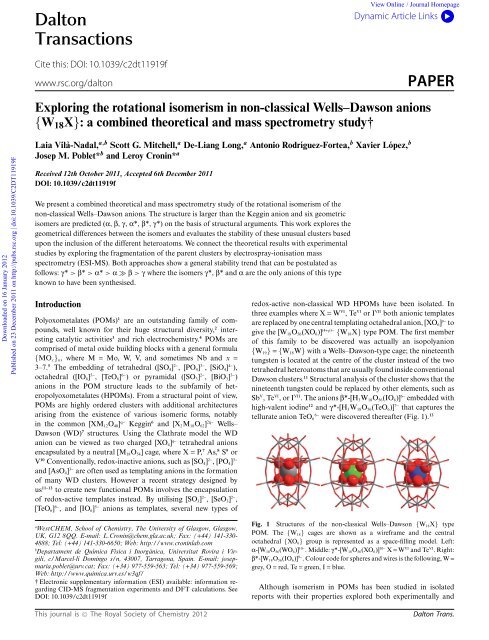
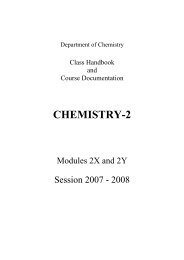

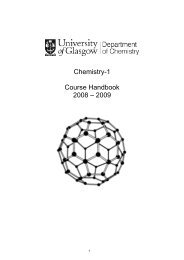
![Chemistry Study [PDF] - University of Glasgow](https://img.yumpu.com/26854063/1/184x260/chemistry-study-pdf-university-of-glasgow.jpg?quality=85)
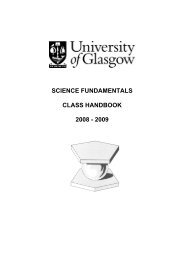
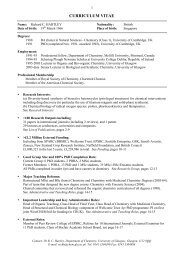

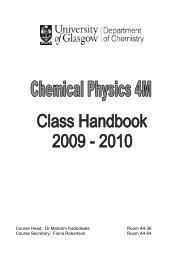

![Environmental Chemistry Study [PDF] - University of Glasgow](https://img.yumpu.com/26854018/1/184x260/environmental-chemistry-study-pdf-university-of-glasgow.jpg?quality=85)


